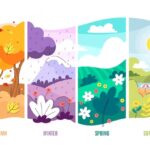The Four Seasons
The four seasons are different times of the year when we experience distinct weather conditions.
Temperature, daylight, and animal behavior vary with each season
The four seasons repeat in a pattern every year
Winter ⇨ Spring ⇨ Summer ⇨ Fall
Let’s look at the four seasons in North America.
Winter (December to February):
- Winter is the coldest season, with snow and freezing rain
- Daytime is shorter
- Animals hibernate
- Weather Event: Blizzards are winter storms with heavy snowfall and high-speed winds
FUN FACT: Snowflakes come in different sizes, but all snowflakes have six sides
Spring (March to May)
- Air gets warmer, and the snow melts
- Flowers bloom, and trees grow
- Animals come out of hibernation
- Weather Event: Thunderstorms and tornadoes are on the rise
FUN FACT: The “Full Worm Moon” is the first full moon in March when worms and beetles come out of the ground after winter.
Summer (June to August)
- Summer is the hottest season
- Days are the longest
- Plants are full of leaves and fruits
- Weather Event: Maximum number of wildfires occur in summer
FUN FACT: The town of Barrow in Alaska has continuous daylight for two months in summer
Fall (September to November)
- Leaves change color
- Days start becoming shorter and cooler
- Animals start storing food for the winter
- Weather Event: Tropical storms and hurricanes peak during fall
FUN FACT: The original leaf colors of yellow and orange show in fall when the green color fades away due to less sunlight!


Recent Comments